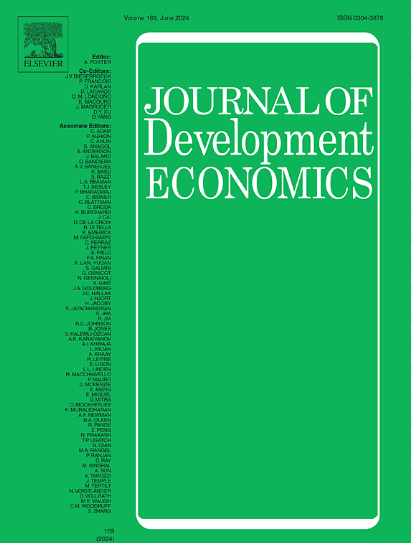Understanding social safety nets and intra-household food allocation: Experimental evidence from Bangladesh
IF 4.6
1区 经济学
Q1 ECONOMICS
引用次数: 0
Abstract
Evidence shows that social protection can improve diets, but little is known about how impacts vary within households, the extent to which the modality of the transfer affects how it is distributed across all household members, whether adding training on the importance of nutrition and diets alters the way transfer resources are allocated within the household, relative to a transfer alone, and if differences in allocations are shaped by differences in livelihood opportunities. We use individual food intake data from two randomized control trials fielded in rural Bangladesh to address these questions. Our results overwhelmingly demonstrate that food gains are distributed equally, regardless of the type of transfers households received (cash, food, or combination), inclusion of nutrition training, regional context, or specific dietary outcome measured. These patterns of findings hold when we consider several extensions: (1) analyzing more aggregated demographic groups; (2) considering alternative measures of diet; (3) analyzing shares rather than levels; (4) considering impacts relative to deprivation at baseline; (5) analyzing impacts on non-food outcomes that can be assigned demographically; (6) re-estimating impacts using alternate samples and alternate estimation models. Where the few significant differences are found, they are often small in magnitude and in favor of children.
理解社会安全网和家庭内部粮食分配:来自孟加拉国的实验证据
有证据表明,社会保护可以改善饮食,但对于家庭内部的影响如何变化、转移支付方式对其在所有家庭成员中的分配有多大影响、增加营养和饮食重要性的培训是否会改变转移支付资源在家庭内部的分配方式(相对于单独的转移支付而言)以及分配的差异是否受到生计机会差异的影响,我们知之甚少。我们使用来自孟加拉国农村地区的两项随机对照试验的个人食物摄入数据来解决这些问题。我们的研究结果压倒性地表明,无论家庭获得的转移支付类型(现金、食物或组合)、是否包括营养培训、地区背景或衡量的具体饮食结果如何,粮食收益都是平均分配的。当我们考虑几个扩展时,这些发现模式成立:(1)分析更多聚集的人口群体;(2)考虑其他饮食措施;(3)分析份额而非水平;(4)考虑相对于基线剥夺的影响;(5)从人口统计学角度分析对非粮食结果的影响;(6)利用交替样本和交替估计模型重新估计影响。在发现少数显著差异的地方,它们的幅度往往很小,而且有利于儿童。
本文章由计算机程序翻译,如有差异,请以英文原文为准。
求助全文
约1分钟内获得全文
求助全文
来源期刊

Journal of Development Economics
ECONOMICS-
CiteScore
8.30
自引率
4.00%
发文量
126
审稿时长
72 days
期刊介绍:
The Journal of Development Economics publishes papers relating to all aspects of economic development - from immediate policy concerns to structural problems of underdevelopment. The emphasis is on quantitative or analytical work, which is relevant as well as intellectually stimulating.
 求助内容:
求助内容: 应助结果提醒方式:
应助结果提醒方式:


